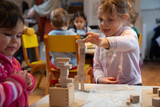Montessori & Technology: do they play well together?
Dr. Maria Montessori’s method of teaching children emphasizes the use of concrete materials and hands-on learning to support the natural development of a child’s physical, social, emotional, and cognitive abilities. It’s a philosophy that’s still going strong more than 115 years after she opened the first Montessori school in Italy in 1907.
But, Dr. Montessori could never have foreseen the technological advances that children have ready access to today, or anticipated the need to develop digital literacy in addition to language and math skills. Given the Montessori focus on experiential learning, is there a place for technology in Montessori education?
DISADVANTAGES OF USING TECH
The results of a recent study published in the journal JAMA Pediatrics showed an association between screen exposure among 1-year-olds and developmental delays in communication, fine motor skills, problem-solving, and personal and social skills at ages 2 and 4 years. Technology appears contrary to Montessori methods in several ways:
- Montessori education emphasizes hands-on learning and tactile experiences. Introducing technology could lead to a shift away from physical interactions, which hinders the development of sensory and fine motor skills.
- Social interaction, cooperation, and communication are key components of Montessori education. Use of technology can be a solitary activity if not properly integrated into group activities.
- Traditional Montessori materials are usually open-ended and encourage creativity. Some technology-based learning tools may be more structured and limit a child’s imagination and problem-solving skills.
- Technology can be highly engaging, but it can also lead to a shorter attention span and increased distractibility, which goes against the Montessori philosophy of concentration and focus on tasks.
- Many educational technologies are designed to be visually and auditorily stimulating, which can overwhelm young learners and hinder their ability to focus and engage with learning materials.
- Montessori education relies on individualized learning and personalized guidance from teachers. Overreliance on technology could lead to a situation where students don’t receive the tailored attention they need to progress at their own pace.
- Excessive screen time has been associated with many health issues, including eyestrain, sleep disturbances, and even cognitive and social development issues in young children. Montessori education values a balanced and holistic approach to child development.
- Technology evolves quickly, and educational tools can become outdated or incompatible. Montessori materials, on the other hand, have stood the test of time due to their timeless and universally relevant design.
In addition, parents who enroll their children in Montessori schools likely value limited exposure to screens and technology for their kids. Introducing technology would be a concern for those parents who prefer their kids to have a tech-free early childhood experience.
To address these disadvantages, any integration of technology into Montessori education should be thoughtful, carefully planned, and aligned with the core principles of the Montessori philosophy.
HOW TECH SUPPORTS MONTESSORI PRINCIPLES
Some proponents believe that technology does have a place in the Montessori classroom. When technology is used as a tool to complement, rather than replace, hands-on experiences and interactions, there are a number of ways it could support and enhance the core principles of Montessori education:
- Adaptive learning software can assess a student’s strengths and weaknesses and help educators design tailored content to meet the student’s needs.
- Technology can be used to complement hands-on learning if it offers appropriate interactive simulations, virtual manipulations, and digital versions of Montessori materials.
- Students may use technology to research and access a wealth of information beyond their immediate environment, sparking curiosity and inquiry.
- When technology is used judiciously, it can provide students with real-world applications and connections. This might involve online collaborations, virtual field trips, or exploring contemporary issues through digital media.
- Digital tools can help teachers observe and assess student progress, enabling them to provide timely feedback and targeted support.
Any use of technology must align with Montessori principles and be carefully introduced to ensure it complements the child’s natural learning process. As technology and education evolve, Montessori schools should consider the benefits and challenges that technology brings while staying true to the core principles of the Montessori method.
SUITABLE TECHNOLOGY FOR MONTESSORI
Technology can enhance Montessori education when used as a tool to support the core principles of the Montessori method. These are a few types of technology that could be considered suitable for Montessori classrooms:
- Carefully selected apps and software can supplement certain learning experiences that align with Montessori principles. They should focus on promoting exploration, creativity, and critical thinking.
- Access to a curated digital library can supplement the physical books available in the classroom, providing additional resources for research and exploration.
- For older students, coding and robotics activities foster problem-solving skills and computational thinking.
- Older students may find that using online platforms for collaborative projects can simulate real-world collaboration, enabling them to work with peers beyond the classroom.
It’s crucial to remember that technology is a tool and is not meant to replace traditional Montessori materials and learning. The successful integration of technology into the Montessori curriculum requires the thoughtful selection of digital resources that align with Montessori principles. Educators should carefully consider the purpose and impact of technology to ensure it complements and enriches the child’s journey of self-discovery and independence.
Digital content should be carefully structured to ensure it aligns with the principles of fostering independence, self-directed learning, and critical thinking. Screen time should be short and focused. The emphasis should always be on maintaining a balance between hands-on, tangible learning experiences and the use of technology.
Thinkamajigs offers a wide variety of Montessori and Montessori-inspired teaching materials, educational toys, games, and related products, and we are constantly adding new items from around the world. While each product's educational benefits and merits are first and foremost, we also ensure that every item meets our high standards of quality, durability, safety, and value, so you can be confident you’re buying a great product at a great price with great customer service.
Please visit our website, call us at 1-800-363-3013, or contact us here.
LATEST BLOG POSTS
How To Set Up A Montessori Environment At Home
Creating a Montessori-inspired environment at home provides the opportunity to support your child's...
Montessori & Technology: do they play well together?
Dr. Maria Montessori’s method of teaching children emphasizes the use of concrete materials and hand...
Froebel Gifts: An Introduction
You may have heard of Fröebel Gifts (we carry the full selection here), but you may also wonder what...
Safe Toys for Toddlers: What Parents Should Know
As a parent, you want to be sure that any toys your toddler plays with are safe and age-appropriate....
Infant & Toddler Toy Guide - Part 2
THINKAMAJIGS’ GUIDE TO CHOOSING EDUCATIONAL TOYS FROM BIRTH TO AGE 3PART 2: AGE-RELATED DEVELOPMENTA...
Infant & Toddler Toy Guide - Part 1
THINKAMAJIGS’ GUIDE TO CHOOSING EDUCATIONAL TOYS FROM BIRTH TO AGE 3PART 1: SKILLS DEVELOPMENT“What...







